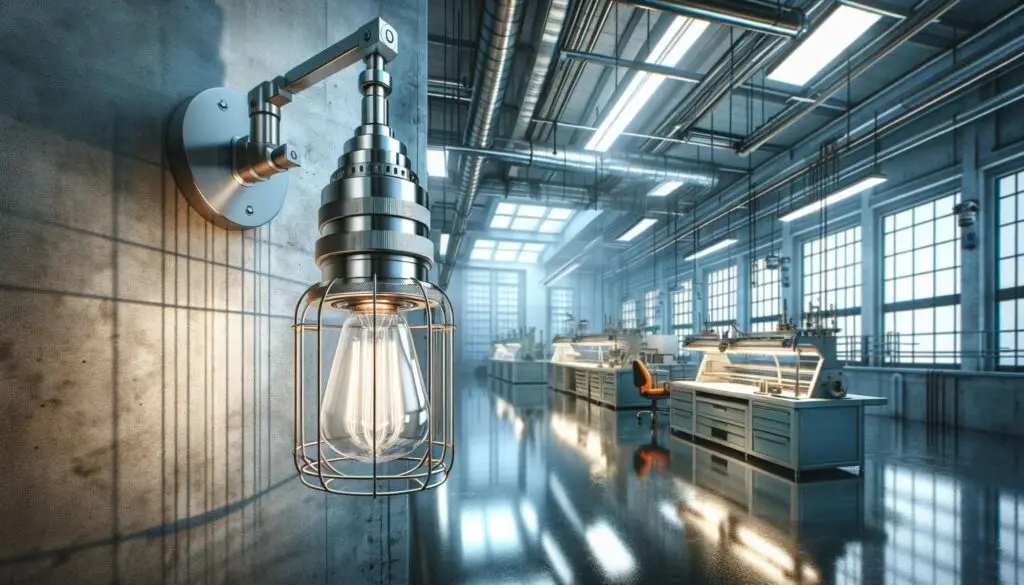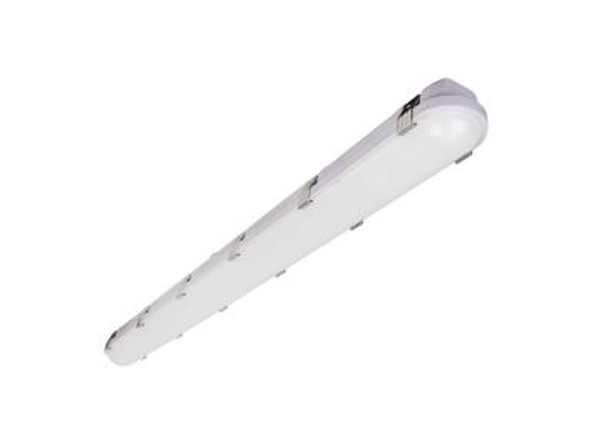17 min read
When it comes to lighting your space, you want options that last and keep you safe. Vapor-proof lighting is designed to handle moisture, dust, and tough conditions without failing.
But how do you know which one is right for your needs? Choosing the right vapor-proof lighting can save you time, money, and frustration. You’ll discover exactly what to look for and how to pick the best lighting that protects your space and keeps things shining bright.
Keep reading to make a smart choice that works perfectly for you.
Importance Of Vapor-proof Lighting
Vapor-proof lighting is designed to work safely in wet or damp places. It stops moisture from reaching electrical parts.
Choosing the right vapor-proof lights helps protect your home or business from damage and hazards.
Safety In Moist Environments
Moist places like bathrooms and kitchens need special lighting to avoid accidents. Vapor-proof lights keep water out.
This helps prevent shocks and keeps people safe while using the light fixtures.
Preventing Electrical Hazards
Water can cause short circuits or fires if it reaches electrical parts. Vapor-proof lighting blocks moisture well.
Using these lights lowers the risk of electrical problems in damp or wet areas.
- Seals prevent water entry
- Protects wiring and bulbs
- Reduces chance of electrical fires
Extending Fixture Lifespan
Moisture can damage light fixtures over time. Vapor-proof lights resist corrosion and rust.
This helps your lights last longer and saves money on repairs or replacements.
- Prevents metal parts from rusting
- Keeps bulbs and wiring dry
- Maintains light quality over time

Credit: logoslighting.com
Key Features Of Vapor-proof Lights
Vapor-proof lights are designed to work in damp or wet places. They keep moisture and dust out to protect the light.
Choosing the right vapor-proof light means looking at its main features. These features help the light last longer and work safely.
Sealing And Enclosure Ratings
Good sealing stops water and dust from getting inside the light. This keeps the electrical parts safe and dry.
Look for enclosure ratings like IP65 or higher. These numbers show how well the light blocks dirt and water.
- IP65: Protected against water jets and dust
- IP66: Protected against strong water jets
- IP67: Protected against temporary water immersion
Material Durability
The materials used in vapor-proof lights must be strong. They should handle heat, cold, and rough use without breaking.
Common durable materials include polycarbonate and aluminum. These keep the light safe from cracks and damage.
- Polycarbonate: Tough and impact resistant
- Aluminum: Lightweight and strong
- Tempered glass: Heat and impact resistant
Corrosion Resistance
Vapor-proof lights often face moisture and chemicals. Corrosion resistance stops rust and damage to the light’s parts.
Materials like stainless steel or coated metals help the light last longer in wet places.
- Stainless steel resists rust and corrosion
- Powder-coated metals protect from chemicals
- Non-metal parts avoid corrosion
Types Of Vapor-proof Fixtures
Vapor-proof lighting fixtures keep moisture and dust out. They work well in damp or dusty places.
There are different types of vapor-proof fixtures. Each type uses a different light source.
Led Vapor-proof Lights
LED vapor-proof lights use light-emitting diodes. They save energy and last a long time.
These lights give bright, clear light. They work well in cold and wet places.
- Low power use
- Long lifespan
- Fast start-up
- Durable and shock-resistant
Fluorescent Vapor-proof Fixtures
Fluorescent vapor-proof fixtures use gas-filled tubes. They give soft, even light.
These fixtures use less energy than incandescent bulbs. They work well in many indoor places.
- Good light spread
- Energy efficient
- Cooler than incandescent
- Requires ballast to work
Incandescent Options
Incandescent vapor-proof lights use a heated filament to create light. They give warm, natural light.
These lights use more energy and last shorter. They are simple and easy to replace.
- Warm light color
- Simple design
- Higher energy use
- Shorter lifespan

Credit: industriallightingfixtures.org
Choosing The Right Fixture For Your Space
Selecting the right vapor-proof lighting fixture is key for safe and efficient lighting. The fixture must suit your space and its needs.
Understanding your environment and lighting goals helps you pick the best vapor-proof fixture. This guide covers what to consider.
Assessing Environmental Conditions
Check the humidity, temperature, and exposure in your space. Vapor-proof lights are designed to resist moisture and dust.
Choose fixtures with proper IP ratings for wet or damp areas. Higher ratings mean better protection against water and dust.
- IP65 or higher for wet locations
- Materials that resist corrosion
- Temperature range suitable for your area
Matching Light Output And Color Temperature
Pick a fixture that provides enough light for your tasks. Too little light can cause eye strain, too much wastes energy.
Color temperature affects mood and visibility. Warmer light feels cozy, cooler light improves focus and clarity.
- 3000K for warm, relaxing light
- 4000K for neutral, natural light
- 5000K or higher for bright, daylight-like light
Installation Considerations
Plan where and how to install the fixture. Vapor-proof lights may need special mounting or wiring to keep seals intact.
Ensure easy access for maintenance. Follow all local codes and safety rules to avoid problems later.
- Use sealed conduit or wiring methods
- Keep fixture seals clean and tight
- Choose mounting options that suit your space
- Check for compatibility with dimmers or controls
Maintenance Tips For Vapor-proof Lighting
Vapor-proof lighting needs regular care to work well. Proper maintenance keeps lights safe and bright.
Follow simple steps to clean, check, and replace parts. This extends the life of your lighting.
Regular Cleaning Procedures
Clean vapor-proof lights often to remove dirt and dust. Use a soft cloth with mild soap and water.
Avoid harsh chemicals that can damage the light cover. Dry the surface completely before turning it on.
- Turn off power before cleaning
- Wipe gently to avoid scratches
- Check for dirt inside the cover
- Dry thoroughly to prevent moisture
Inspecting Seals And Gaskets
Seals and gaskets keep moisture out of vapor-proof lights. Check them regularly for cracks or damage.
Replace any worn seals to keep the lighting safe from water and dust. Good seals prevent corrosion and short circuits.
- Look for cracks or hardening
- Make sure seals fit tightly
- Replace damaged seals immediately
- Use seals made for your light model
Replacing Components Safely
Turn off power before replacing bulbs or parts. This prevents electric shocks and damage.
Use the correct replacement parts. Follow the manufacturer’s instructions for safe installation.
- Power off and unplug the light
- Use parts made for vapor-proof lights
- Handle bulbs with care
- Tighten all seals after replacement
Common Mistakes To Avoid
Choosing the right vapor-proof lighting is important for safety and durability. Many people make mistakes that reduce the light’s effectiveness. Avoid these common errors to get the best results.
Understanding what to look for helps protect your investment. This guide points out key mistakes to avoid when selecting vapor-proof lighting.
Ignoring Ip Ratings
IP ratings show how well a light protects against dust and water. Ignoring these ratings can lead to damage or failure.
Choose lights with the right IP rating for your environment. For wet or dusty areas, higher ratings are necessary.
- IP65 means protection from water jets and dust
- IP67 means protection from temporary water immersion
- Lower IP ratings are not safe for moist places
Using Non-compatible Bulbs
Not all bulbs work well in vapor-proof fixtures. Using the wrong bulb can cause heat buildup or poor lighting.
Always check the fixture’s specifications before buying bulbs. Use bulbs designed for enclosed and damp locations.
- LED bulbs are often best for vapor-proof fixtures
- Incandescent bulbs may cause heat problems
- Using incompatible bulbs can void warranties
Neglecting Professional Installation
Installing vapor-proof lighting incorrectly can cause leaks and safety hazards. Many people skip hiring a professional.
Experts ensure the lights are sealed properly and wired safely. Proper installation extends the life of your lighting.
- Professionals know local electrical codes
- They prevent gaps where moisture can enter
- Proper installation avoids costly repairs later
Energy Efficiency And Cost Factors
Choosing vapor-proof lighting means thinking about energy use and cost. Good lighting saves money and lasts longer.
Energy-efficient lights use less electricity and lower bills. Cost matters both when buying and over time.
Comparing Initial And Long-term Costs
Vapor-proof lights can cost more at first. This is the initial price for buying and installing.
Long-term costs include energy bills and maintenance. Cheaper lights may cost more over time.
- Initial cost: price to buy and install the light
- Energy cost: electricity needed to run the light
- Maintenance cost: fixing or replacing parts
- Long life reduces the need to buy new lights
Benefits Of Led Vapor-proof Lights
LED vapor-proof lights use less energy than other types. They last a long time and save money.
These lights work well in wet or dusty places. They need less fixing and use less power.
- Lower electricity use compared to traditional bulbs
- Long lifespan reduces replacement needs
- Strong and resistant to moisture and dust
- Less heat means safer and more efficient
Incentives And Rebates
Many areas offer rebates for energy-efficient lighting. These lower the cost of buying LED vapor-proof lights.
Check with local utility companies or government programs. They may have money back or discounts.
- Rebates reduce initial purchase price
- Incentives encourage using energy-saving products
- Programs vary by location and time
- Look online or ask your supplier for offers

Credit: relightdepot.com
Frequently Asked Questions
What Is Vapor-proof Lighting?
Vapor-proof lighting is designed to resist moisture and vapor penetration. It protects electrical components in damp or wet environments. These lights ensure safety and durability in places like kitchens, bathrooms, and industrial settings.
Why Choose Vapor-proof Lighting For Damp Areas?
Vapor-proof lighting prevents corrosion and electrical hazards caused by moisture. It extends fixture lifespan and maintains consistent illumination in humid conditions. This choice enhances safety and reduces maintenance costs in damp environments.
Where Is Vapor-proof Lighting Commonly Used?
It is commonly used in bathrooms, kitchens, basements, garages, and industrial spaces. Any area exposed to moisture or vapor benefits from vapor-proof lighting. This ensures reliable and safe lighting performance.
How To Install Vapor-proof Lighting Safely?
Installation should follow manufacturer guidelines and local electrical codes. Ensure fixtures are properly sealed and mounted to avoid vapor entry. Using a qualified electrician is recommended for safe and effective installation.
Conclusion
Choosing the right vapor-proof lighting ensures safety and efficiency. It’s essential for damp and hazardous locations. Always consider durability and energy efficiency. Evaluate the installation space carefully. This helps in selecting the right fixture. Good lighting improves visibility and reduces risks.
It’s crucial for workplaces needing reliable illumination. Quality lighting saves costs in the long run. It also enhances productivity and safety. Remember, invest in lighting that meets your specific needs. Make informed decisions. This way, you ensure long-term benefits and peace of mind.

